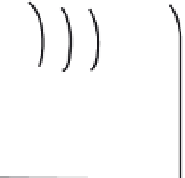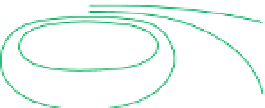Geoscience Reference
In-Depth Information
coil by changing the strength of a magnetic
field experi-
enced by the coil through a phenomenon known as elec-
tromagnetic induction.
Figure 5.9a
shows two coils in close
proximity to each other. One coil, which we will refer to as
the transmitter coil, has a current passing through it. The
associated magnetic
field will be called the primary mag-
netic
field. The emf induced in the second coil is moni-
tored. This coil will be referred to as the receiver coil.
The magnitude of the induced emf (
a)
Current
flow
direction
S
N
Field
direction
in centre
of coil
I
) in volts (V) is
proportional to the rate of change of the magnetic field (
ε
d.c. current flow
)
experienced by the coil, i.e. it depends on how fast the
magnetic field changes. The induced emf is given by the
expression,
ψ
Magnetic field lines
b)
S
N
d
dt
ε ¼
ð
5
:
7
Þ
This
is known as Faraday
'
is Law of electromagnetic
induction.
Consider the case of d.c.
flowing through the transmitter
changing primary magnetic
field so there is no induction in
the detector coil. When the current is turned on a steady-
state magnetic
field is rapidly established. Only at the
instances of turn-on and, later, at turn-off does the receiver
coil experience a change in the magnetic
field. Simultan-
eously and instantaneously, an emf pulse is induced into
the receiver coil causing a current to
flow. At other times
when a steady-state current is established, the magnetic
field experienced by the receiver coil is once again constant
so there is no emf induced in it. A crucial characteristic of
the induced emf is that it causes a current to flow in the
receiver coil whose magnetic field attempts to prevent the
field around the coil from changing. The negative sign in
Eq. (5.7)
indicates that the induced emf opposes the change
in the primary magnetic
Figure 5.8
The magnetic
fields of (a) a current-carrying coil and (b) a
bar magnet.
overcome before it can vary its rate and direction of
ow.
A coil, and a single-turn loop, exhibits the inductive effect
owing to the linkage between the magnetic
fields associated
with the current
flowing through the turns of the coil. It is
dependent only on the geometry of the coil/loop and
increases with increasing number of turns, and is known
as its self-inductance. Coils and loops are referred to as
inductances or inductors.
In terms of a steady direct current, there is no change in
the current flow through a coil except when it is abruptly
turned on or off. These changes create a
'
counter
'
voltage or
'
that opposes the change in applied voltage and
causes variations in the current flow to lag behind variations
each cycle of the continuously changing current is opposed
by the inductance, which hinders the current flow. The level
of this hindrance increases with the rate of change, i.e. with
increasing frequency. The effect is known as inductive react-
ance and is a form of impedance. The lag in current varies
between 0° and 90° (being greatest when the resistance of
the external circuit is least), opposite to that caused by
capacitive reactance. The effects of inductance, and the back
emf, are important issues in the creation of the magnetic
fields used in EM surveying (see
Section 5.7.1.2
).
back emf
'
field. Induction at the instance of
a change-in-state of a magnetic
field is the basis of time
domain EM measurements (see
Section 5.7
)
. Note that the
polarity of the induced emf is opposite at turn-on and
turn-off. In the description of EM methods in
Section 5.7
we describe the induction processes at turn-off, when the
induced current
flow attempts to recreate the primary
magnetic
field.
Consider now the case of a.c.
flowing through the trans-
produces a magnetic
field that continuously changes in
amplitude and direction. The receiver coil continually
experiences the changing magnetic field, not just when
the current is turned on and off, but for all the time that
5.2.2.2
Electromagnetic induction
Here we investigate the relationships between time-varying
magnetic and electric fields. An emf can be induced into a































































Search WWH ::

Custom Search